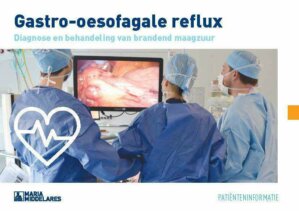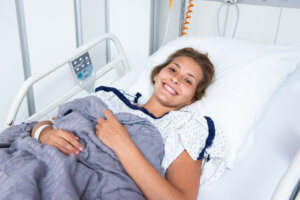Treatment of reflux
Gastroesophageal reflux disease (GERD) can be treated surgically and non-surgically (conservatively).
Non-surgical treatment
Non-surgical treatment- Losing weight has been proven to be useful for patients who are overweight or who recently gained weight. We strongly recommend this. Strive for an ideal weight.
- Avoid fatty or spicy foods, caffeine, chocolate, fizzy drinks, peppermint, etcetera. These foods promote the production of stomach acid or relax the oesophageal sphincter. Also avoid acidic foods such as concentrated tomato and fruit juices.
- The last meal should be consumed no later than two to three hours before going to bed. Eat with moderation and in relaxed conditions.
- Avoid strenuous physical effort immediately after meals.
- Stop smoking or smoke less. Tobacco may make reflux symptoms worse.
- Raising the head end of the bed can be helpful, especially in patients with nocturnal symptoms or coughing/hoarseness.
- Avoid having your stomach constricted by a corset.
The majority of patients can be treated with medication that reduces the production of stomach acid or that neutralises the acid.
- Antacids, such as Rennie®, Maalox®, Antagel® and Gaviscon®, are products that neutralise the acidity of the stomach, causing a mild improvement in symptoms without actually avoiding reflux. They work within five minutes, but only have a short-term effect of 30-60 minutes.
- A proton pump inhibitor (PPI), such as omeprazole (Losec®), rabeprazole (Pariet®), pantoprazole (Pantozol®) and esomeprazole (Nexium®), is the most potent drug that decreases stomach acid production with a faster improvement of reflux symptoms. They are the first choice for severe erosive oesophagitis, severe or frequent GORD symptoms that impact the quality of life or for Barrett's oesophagus.
- Alginates (sucralfate) bind to the surface of the mucous membrane. They form a kind of ‘coating’ that can speed up healing and reduce oesophagus sensitivity. In view of their short-term and limited effect compared to PPIs, they are only used to treat GORD in pregnant women or for oesophagitis that is difficult to treat.
Surgical treatment
Surgical treatment- When antacid drugs and lifestyle adjustments have insufficient effect on reflux symptoms (failing medicated therapy).
- Surgery may also be considered if patients do not want to take antacids for the rest of their lives, if medication is not well tolerated or if medication is not taken reliably.
- Surgical treatment is used when complications of reflux occur. These might include an inflammation of the oesophagus (oesophagitis) that does not heal properly or keeps recurring, benign narrowing of the oesophagus (benign stricture), Barrett's metaplasia (without severe dysplasia or carcinoma) or asthma.
- If the patient is in full health, no specific preparations are necessary. However, smokers are advised to stop smoking because of the increased risk of lung infection, thrombosis (clot in blood vessel) and wound infections.
- In case of known lung conditions, such as asthma or emphysema (COPD), the lungs must be in optimal condition before surgery is carried out.
- The patient must fast from midnight on the day of the procedure.
- Certain medication may still be taken on the morning of the day of the surgery: this will be decided by the attending physician. The intake of blood thinners should be reported: certain types should be stopped several days before the procedure.
The surgery is always performed under general anaesthetic and usually in the form of keyhole surgery (laparoscopy). This involves inflating the abdomen with carbon dioxide gas to create a working space. Instruments are inserted through five small holes in the abdominal wall to perform the surgery. An advantage of this method compared to the ‘classic’ procedure is that the hospitalisation and recovery periods are often shorter because the wound is much smaller.
In exceptional cases (e.g. if there is too much scar tissue from previous operations in the upper abdomen), the same operation can be done with a classic incision. This involves a larger scar, a slightly longer hospitalisation and recovery period.
The most common surgical technique is the Nissen operation. During this operation, the part of the stomach that has risen into the chest cavity is returned to the abdomen. If the opening in the diaphragm is too large, it is made smaller. The top of the stomach is detached from the spleen. This part of the stomach is then wrapped around the oesophagus and attached to the front of the stomach (like a cuff).
Variations of the Nissen fundoplication exist where the cuff is not fully wrapped around the stomach but only partially so, as for the Dor or Toupet fundoplication. In highly exceptional cases, the procedure involves partial cuffing through the left chest. This is known as the Belsey fundoplication.
Contrast swallow
A contrast swallow is performed on the first day after the operation. This requires the patient to drink a contrast fluid to see if there is a smooth passage at the oesophagus-stomach transition around which the cuff is placed. This can also rule out any leaks (due to detachment of the stomach).
If the contrast swallow is reassuring, the patient may start with drinks and liquid mixed food. During the admission, a dietitian will be consulted to explain the dietary advice for at home and to provide nutritional schedules.
With smooth intake of drinks and liquid food, the infusion can be removed the second day after surgery. The patient may then be able to go home.
Discharge
The hospitalisation duration depends on a number of factors. Age, overall condition and the patient’s situation at home (e.g. living alone) all play a role. Patients who have undergone surgery using a classic incision will often remain in hospital a bit longer.
As with any surgery, some common complications may occur such as post-operative bleeding, wound infection, thrombosis or lung infection...
These complications can also occur:
- Shoulder pain: pain in the shoulder(s) is a typical complaint that can occur after laparoscopy. This is because the gas used in the procedure stimulates the diaphragm. The nervous system in the shoulders picks it up. The pain disappears spontaneously after a few days.
- Bleeding: during surgery, bleeding to the spleen (or liver) is the most important but fortunately infrequent complication.
- Collapsed lung: a collapsed lung (pneumothorax) may occur when the stomach has detached and pushed up into the chest. This is due to perforation of the lung, which causes air to leak into the chest leading to a partial collapse of the lung. This sometimes requires a drain (plastic tube) to be placed in the chest cavity to remove the air and fluid between the lung membranes and allow for the lung to unfold again.
- Diarrhoea and gastrointestinal disorders: during the procedure, the nerve branches that run along the oesophagus and stomach can be damaged with (usually temporary) diarrhoea and gastrointestinal disorders.
- Stomach perforation: exceptionally, a gastric perforation can occur due to the detachment of the stomach from the spleen or from the chest. This may lead to stomach acids leaking into the abdominal cavity, usually requiring a new operation to repair the perforation.
For 80 to 90% of the patients, good to excellent improvement of reflux is achieved for a minimum of ten years after the procedure. In less than 20% of patients, symptoms persist afterward.
- Approximately 10 to 15% of patients undergoing a Nissen fundoplication experience more difficulty, usually temporary, with food passing through the oesophagus (dysphagia). As a result, patients can lose up to 10% of their weight immediately after the procedure. This dysphagia improves after four to six weeks. Persistent symptoms or excessive weight loss require contact with the surgeon.
- Selection of the right indication (patient with demonstrable complaints or oesophageal damage due to gastroesophageal reflux) is essential to obtain the best results. Individual differences exist too, and precise outcomes cannot be predicted.
- Burping up gases may be more laborious at first. The patient may therefore complain about flatulence or bloating.
- Wound pains: wound pains after surgery are normal to some extent. This pain may persist for a week or even for a number of weeks when coughing or lifting things. This pain may persist for a week or even for a number of weeks when coughing or lifting things. Feel free to use pain relief during this period. The intensity of the pain should decrease progressively. If the pains increase, it is best to check the wounds once in between: you then contact your GP or surgeon.
- Shoulder pain: shoulder pain may occur after any keyhole surgery due to the position during the procedure, but also due to the abdominal cavity being inflated with carbon dioxide. The stretching of the midriff may result in irritation of the nerve to the shoulder. This shoulder pain is no cause for concern and usually disappears after a few days.
- Diet:
- During a Nissen procedure or anti-reflux surgery, the stomach is placed behind and around the oesophagus and secured with a few sutures. To protect the sutures, dietary adjustments are necessary in the first few weeks. After the contrast swallow, the patient is started on fluids and liquid, mixed foods. For the first 14 days after surgery, you should only consume liquid or blended food (step 1).
- You can then gradually switch to soft foods (step 2). Since burping is difficult during the first weeks after the procedure, fizzy drinks must be absolutely avoided.
- Details about the composition of the diet can be found in the following leaflet.
- Medication: anti-reflux medication is generally no longer required after the procedure.
- Sutures: sutures may be removed by the GP on the tenth day after surgery. Until then, wounds are best protected against water. Bandages may be changed when they are soiled or loosened.
- Movement: exercise is indicated as soon as pain allows. Rapid mobilisation reduces the risk of blood clots forming in the blood vessels. Movement should be done within the pain threshold. It is best to wait about three weeks with sports to avoid a small scar fracture at the incision. General fatigue during a number of weeks after the procedure is normal.
Only available in Dutch:

Gastro-oesofagale reflux
DownloadCentres and specialist areas
Centres and specialist areas
Latest publication date: 16/05/2024
Supervising author: Dr Monsaert Els




